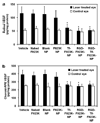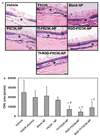Intravenous transferrin, RGD peptide and dual-targeted nanoparticles enhance anti-VEGF intraceptor gene delivery to laser-induced CNV
- PMID: 19194480
- PMCID: PMC2993697
- DOI: 10.1038/gt.2008.185
Intravenous transferrin, RGD peptide and dual-targeted nanoparticles enhance anti-VEGF intraceptor gene delivery to laser-induced CNV
Abstract
Choroidal neovascularization (CNV) leads to loss of vision in age-related macular degeneration (AMD), the leading cause of blindness in adult population over 50 years old. In this study, we developed intravenously administered, nanoparticulate, targeted nonviral retinal gene delivery systems for the management of CNV. CNV was induced in Brown Norway rats using a 532 nm laser. We engineered transferrin, arginine-glycine-aspartic acid (RGD) peptide or dual-functionalized poly-(lactide-co-glycolide) nanoparticles to target delivery of anti-vascular endothelial growth factor (VEGF) intraceptor plasmid to CNV lesions. Anti-VEGF intraceptor is the only intracellularly acting VEGF inhibitory modality. The results of the study show that nanoparticles allow targeted delivery to the neovascular eye but not the control eye on intravenous administration. Functionalizing the nanoparticle surface with transferrin, a linear RGD peptide or both increased the retinal delivery of nanoparticles and subsequently the intraceptor gene expression in retinal vascular endothelial cells, photoreceptor outer segments and retinal pigment epithelial cells when compared to nonfunctionalized nanoparticles. Most significantly, the CNV areas were significantly smaller in rats treated with functionalized nanoparticles as compared to the ones treated with vehicle or nonfunctionalized nanoparticles. Thus, surface-functionalized nanoparticles allow targeted gene delivery to the neovascular eye on intravenous administration and inhibit the progression of laser-induced CNV in a rodent model.
Figures









Similar articles
-
Targeted Intraceptor Nanoparticle for Neovascular Macular Degeneration: Preclinical Dose Optimization and Toxicology Assessment.Mol Ther. 2017 Jul 5;25(7):1606-1615. doi: 10.1016/j.ymthe.2017.01.014. Epub 2017 Feb 22. Mol Ther. 2017. PMID: 28236576 Free PMC article.
-
Inhibition of Hypoxia-Inducible Factor-1α and Vascular Endothelial Growth Factor by Chrysin in a Rat Model of Choroidal Neovascularization.Int J Mol Sci. 2020 Apr 18;21(8):2842. doi: 10.3390/ijms21082842. Int J Mol Sci. 2020. PMID: 32325771 Free PMC article.
-
AAV2 delivery of Flt23k intraceptors inhibits murine choroidal neovascularization.Mol Ther. 2015 Feb;23(2):226-34. doi: 10.1038/mt.2014.199. Epub 2014 Oct 13. Mol Ther. 2015. PMID: 25306972 Free PMC article.
-
RETRACTED: Influence of choroidal neovascularization and biodegradable polymeric particle size on transscleral sustained delivery of triamcinolone acetonide.Int J Pharm. 2012 Sep 15;434(1-2):140-7. doi: 10.1016/j.ijpharm.2012.05.025. Epub 2012 May 23. Int J Pharm. 2012. PMID: 22633904 Free PMC article.
-
[Novel approach for management of age-related macular degeneration--antiangiogenic therapy and retinal regenerative therapy].Nippon Ganka Gakkai Zasshi. 2007 Mar;111(3):232-68; discussion 269. Nippon Ganka Gakkai Zasshi. 2007. PMID: 17402564 Review. Japanese.
Cited by
-
Molecular histopathology using gold nanorods and optical coherence tomography.Invest Ophthalmol Vis Sci. 2013 Feb 1;54(2):1192-200. doi: 10.1167/iovs.12-10794. Invest Ophthalmol Vis Sci. 2013. PMID: 23307958 Free PMC article.
-
Flt23k nanoparticles offer additive benefit in graft survival and anti-angiogenic effects when combined with triamcinolone.Invest Ophthalmol Vis Sci. 2012 Apr 30;53(4):2328-36. doi: 10.1167/iovs.11-8393. Invest Ophthalmol Vis Sci. 2012. PMID: 22427553 Free PMC article.
-
The Optimized Delivery of Triterpenes by Liposomal Nanoformulations: Overcoming the Challenges.Int J Mol Sci. 2022 Jan 20;23(3):1140. doi: 10.3390/ijms23031140. Int J Mol Sci. 2022. PMID: 35163063 Free PMC article. Review.
-
Animal models of choroidal and retinal neovascularization.Prog Retin Eye Res. 2010 Nov;29(6):500-19. doi: 10.1016/j.preteyeres.2010.05.003. Epub 2010 May 19. Prog Retin Eye Res. 2010. PMID: 20488255 Free PMC article. Review.
-
The role of transcytosis in the blood-retina barrier: from pathophysiological functions to drug delivery.Front Pharmacol. 2025 Apr 16;16:1565382. doi: 10.3389/fphar.2025.1565382. eCollection 2025. Front Pharmacol. 2025. PMID: 40308764 Free PMC article. Review.
References
-
- Ambati J, Ambati BK, Yoo SH, Ianchulev S, Adamis AP. Age-related macular degeneration: etiology, pathogenesis, and therapeutic strategies. Surv Ophthalmol. 2003;48:257–293. - PubMed
-
- Zarbin M, Szirth B. Current treatment of age-related macular degeneration. Optom Vis Sci. 2007;84:559–572. - PubMed
-
- Ng EW, Adamis AP. Targeting angiogenesis, the underlying disorder in neovascular age-related macular degeneration. Can J Ophthalmol. 2005;40:352–368. - PubMed
-
- Jani PD, Singh N, Jenkins C, Raghava S, Mo Y, Amin S, et al. Nanoparticles sustain expression of Flt intraceptors in the cornea and inhibit injury-induced corneal angiogenesis. Invest Ophthalmol Vis Sci. 2007;48:2030–2036. - PubMed
-
- Singh N, Amin S, Richter E, Rashid S, Scoglietti V, Jani PD, et al. Flt-1 intraceptors inhibit hypoxia-induced VEGF expression in vitro and corneal neovascularization in vivo. Invest Ophthalmol Vis Sci. 2005;46:1647–1652. - PubMed
Publication types
MeSH terms
Substances
Grants and funding
LinkOut - more resources
Full Text Sources
Other Literature Sources
Medical

